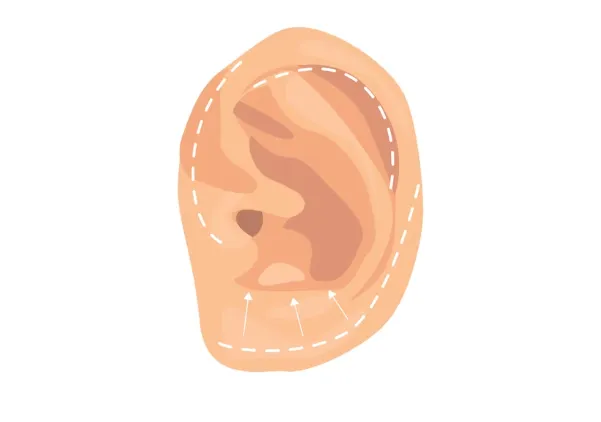Otoplasty, also known as ear surgery or ear reshaping, is a cosmetic procedure designed to alter the ears’ size, shape, or position. It is a popular surgical option for individuals who are dissatisfied with the appearance of their ears or wish to correct birth defects or injuries.
Otoplasty can provide a renewed sense of confidence and self-esteem by creating a more harmonious balance between the ears and other facial features. This article will delve into the various types of ear surgery, provide helpful tips, outline its benefits and side effects, discuss eligibility criteria, explain the step-by-step procedure, and conclude with key insights.
Different Types of Otoplasty
Otoplasty encompasses several techniques that address specific concerns regarding the appearance of the ears. The common types of ear surgery procedures include:
- Ear Pinning: This procedure aims to correct protruding or prominent ears by reshaping the cartilage and bringing them closer to the head for a more natural contour.
- Ear Reduction: Individuals with large or oversized ears can benefit from ear reduction surgery, which involves removing excess skin and cartilage to achieve a more proportionate ear size.
- Ear Augmentation: Some individuals desire enhanced ear shape or size. Ear augmentation, commonly known as earlobe or earlobe reconstruction, involves grafting cartilage or synthetic material to achieve the desired appearance.
- Earlobe Repair: This procedure focuses on repairing torn, stretched, or damaged earlobes caused by trauma or prolonged use of heavy earrings.
Benefits of Otoplasty
Undergoing otoplasty can yield numerous benefits, including:
- Improved Self-Confidence: ear surgery can enhance your self-image and confidence by correcting ear irregularities that may have caused self-consciousness.
- Balanced Facial Proportions: Reshaping the ears can bring balance and harmony to the overall appearance of your face.
- Correcting Birth Defects: Otoplasty can effectively correct congenital ear deformities, such as protruding or misshapen ears, ensuring a more normal appearance.
Otoplasty encompasses several techniques that address specific concerns regarding the appearance of the ears.
Side Effects of Otoplasty
Like any surgical procedure, ear surgery carries a few potential side effects, including:
- Temporary Discomfort: Immediately after the surgery, you may experience mild to moderate pain, which can be managed with prescribed medication.
- Swelling and Bruising: Swelling and bruising around the ears are common side effects but typically subside within a few weeks.
- Numbness or Sensitivity: Temporary changes in sensation, such as numbness or increased sensitivity, may occur but usually resolve over time.
Eligibility for Otoplasty
Determining eligibility for otoplasty involves several factors that your surgeon will assess during a consultation. Here are some key considerations:
Age
Otoplasty can be performed on individuals of various ages, including children and adults. However, the timing of surgery can vary. For children, the ears should be fully developed before undergoing otoplasty, typically around age 5 or 6.
Children
Otoplasty can be performed on children as young as 5 or 6 years old, once the ears have reached full development.
Adults
There is no upper age limit for otoplasty as long as the individual is in good health.

Ear Concerns
Eligibility for otoplasty is often based on specific ear concerns, such as:
Prominent Ears
Individuals with ears that protrude prominently from the head.
Misshapen Ears
Patients with congenital deformities or acquired ear shape irregularities.
Asymmetry
Those with noticeable differences in ear size or position.
Physical Health
Candidates should generally be in good overall health and free from any conditions that may impair healing.
Psychological Readiness
Patients should have a positive outlook and realistic expectations about the outcome of otoplasty.
Motivation
The decision to undergo otoplasty should be driven by personal desire for aesthetic improvement, not external pressures.
Teens and Adults
Adolescents and adults with good overall health and realistic expectations about the procedure can also consider otoplasty.

Consultation with a Surgeon
A comprehensive consultation with a board-certified plastic surgeon specializing in otoplasty is essential. During the consultation, the surgeon will evaluate the ear anatomy, discuss goals, and explain the procedure in detail.
Realistic Expectations
Candidates should understand the potential results and limitations of otoplasty.
Commitment to Post-Operative Care
Eligible candidates must be willing to follow all post-operative instructions provided by the surgeon.
Full otoplasty recovery usually takes between six and eight weeks. But you’ll probably notice visual improvements in two to three weeks. Keep in mind that healing times vary from person to person. Cleve land clinic
The Step-by-Step Process of Otoplasty
The otoplasty procedure typically follows these steps:
- Anesthesia: Your surgeon will administer either local anesthesia with sedation or general anesthesia to ensure your comfort throughout the procedure.
- Incision Placement: The surgeon will make discreet incisions behind the ear or within the natural creases of the ear to minimize visible scarring.
- Cartilage Reshaping: The surgeon will sculpt the cartilage to achieve the desired ear shape and position, addressing specific concerns discussed during the consultation.
- Stitching and Bandaging: Once the cartilage has been reshaped, the surgeon will use internal stitches to secure the ear in its new position. Bandages or dressings will be applied to protect the ears and promote proper healing.
- Recovery and Follow-Up: After the surgery, you will be closely monitored during the initial recovery period. Your surgeon will provide detailed instructions on wound care, activity restrictions, and follow-up visits to ensure optimal healing.

Summary
Otoplasty is a cosmetic surgical procedure that can provide individuals with improved self-confidence, enhanced facial aesthetics, and long-lasting results. Whether correcting protruding ears, reshaping the cartilage, or addressing birth defects, ear surgery offers a way to achieve a more harmonious balance between the ears and other facial features.
By considering the tips provided, understanding the benefits, being aware of the potential side effects, and following the step-by-step procedure, you can make an informed decision regarding ear surgery and embark on a transformative journey towards enhanced self-image and overall well-being.
Fun fact: Did you know? While many know about common cosmetic procedures like nose jobs or facelifts, Otoplasty surgery is a specialized form of ear reshaping that’s been changing lives. Auricular correction, a term often used in medical circles, focuses on enhancing ear aesthetics.
Like other plastic surgery techniques, Otoplasty stands out because of its unique approach to bringing harmony to one’s facial features. It’s truly amazing how such a targeted change can profoundly impact one’s overall appearance and confidence!
FAQs
- Is otoplasty a painful procedure? ear surgery is performed under anesthesia, so you will not experience pain during the surgery.
2. How long does it take to recover from otoplasty? The recovery time varies for each individual but typically ranges from one to two weeks.
3. What happens during an otoplasty procedure?
During otoplasty:
- Incisions are usually made behind the ears to access the cartilage.
- The cartilage is reshaped, bent, or trimmed to achieve the desired look.
- Excess skin may be removed if necessary.
- The incisions are then closed with sutures.
4. Is otoplasty a painful procedure?
Otoplasty is performed under local anesthesia with sedation or general anesthesia, depending on the complexity of the procedure and patient preference. Patients may experience some discomfort and mild pain after the surgery, which can be managed with pain medications prescribed by the surgeon.
5. What is the recovery like after otoplasty?
Recovery from otoplasty typically involves:
- Wearing a protective headband or dressing over the ears for a few days to weeks.
- Mild swelling and bruising around the ears, which usually subsides within a few weeks.
- Avoiding strenuous activities and contact sports for several weeks.
- Following post-operative care instructions provided by the surgeon.
Otoplasty (Cosmetic Ear Surgery): Procedure & Recovery (clevelandclinic.org)




